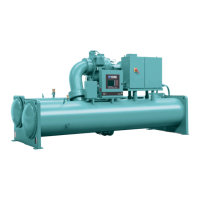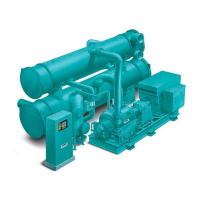Decommissioning, dismantling, and disposal
Unless otherwise indicated, the operations described in the following list can be performed by any
correctly trained maintenance technician.
1. Isolate all sources of electrical supply to the unit, including any control system supplies
switched by the unit. Make sure that all points of isolation are secured in the off position.
2. Disconnect and remove the supply cables. For connection points, see Handling, storage,
installation and reassembly.
3.
Fill the interior of the unit with N
2
gas to pressurize up to approximately 1.5 ~ 3 psig.
4. Prepare a suitable container. See Table 8.
5. Drain the remaining solution and refrigerant in the unit from each service valve as completely
as possible into a container.
6. Dispose of the solution and refrigerant in a suitable and safe manner.
7. Isolate the unit heat exchanger from the external water systems and drain the heat exchanger
section of the system. If no isolation valves are installed it is necessary to drain the complete
system.
8. If glycol is used in the water system, or chemical additives are contained, dispose of the
solution in a suitable and safe manner. Under no circumstances drain any system containing
glycol directly into domestic waste or natural water systems.
9. After draining, disconnect and remove the water.
10. Remove fixing down bolts, and then lift the unit from position, using the points provided and
equipment with adequate lifting capacity.
See Handling, storage, installation and reassembly for unit installation instructions, and Table 8 for
unit weights.
Make sure that while components are being removed, the remaining parts are supported in a safe
manner.
CAUTION
Only use lifting equipment of adequate capacity.
After removing the unit from position, dispose of the unit parts according to local laws and
regulations.
177YHAU-C Single Effect Steam-Fired Absorption Chiller

